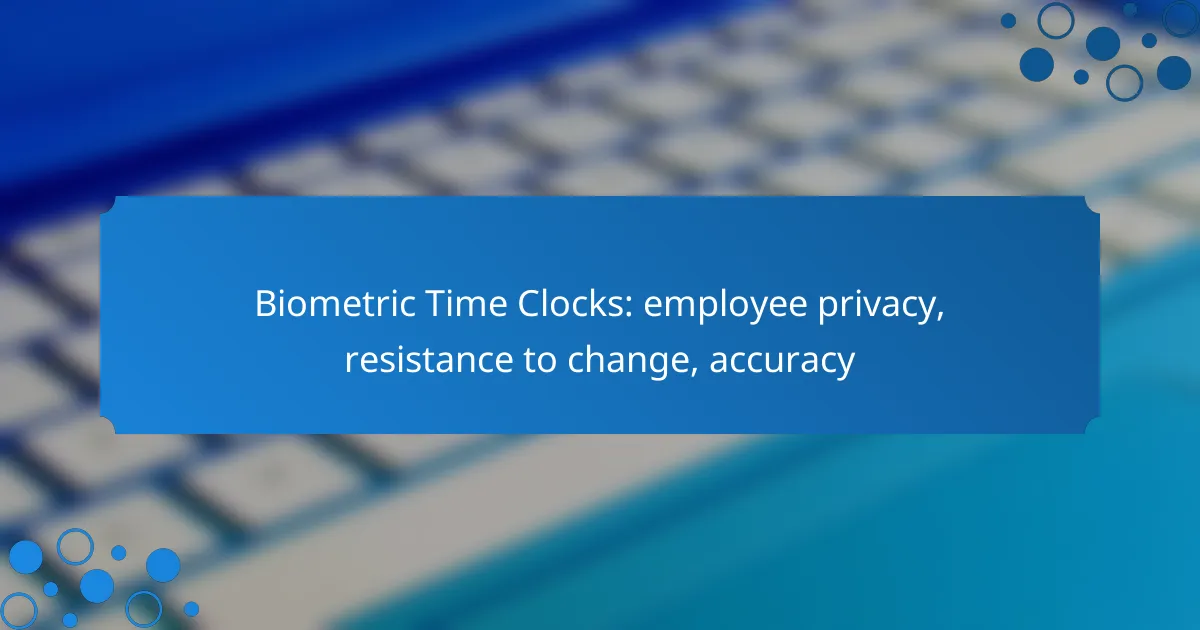Biometric time clocks represent a significant advancement in employee timekeeping, enhancing privacy by securely capturing unique physical traits while ensuring compliance with privacy laws. However, their implementation often faces resistance due to employee concerns about surveillance and the challenges of adapting to new technology. Despite these hurdles, biometric systems provide superior accuracy compared to traditional methods, effectively minimizing issues like time theft and buddy punching.
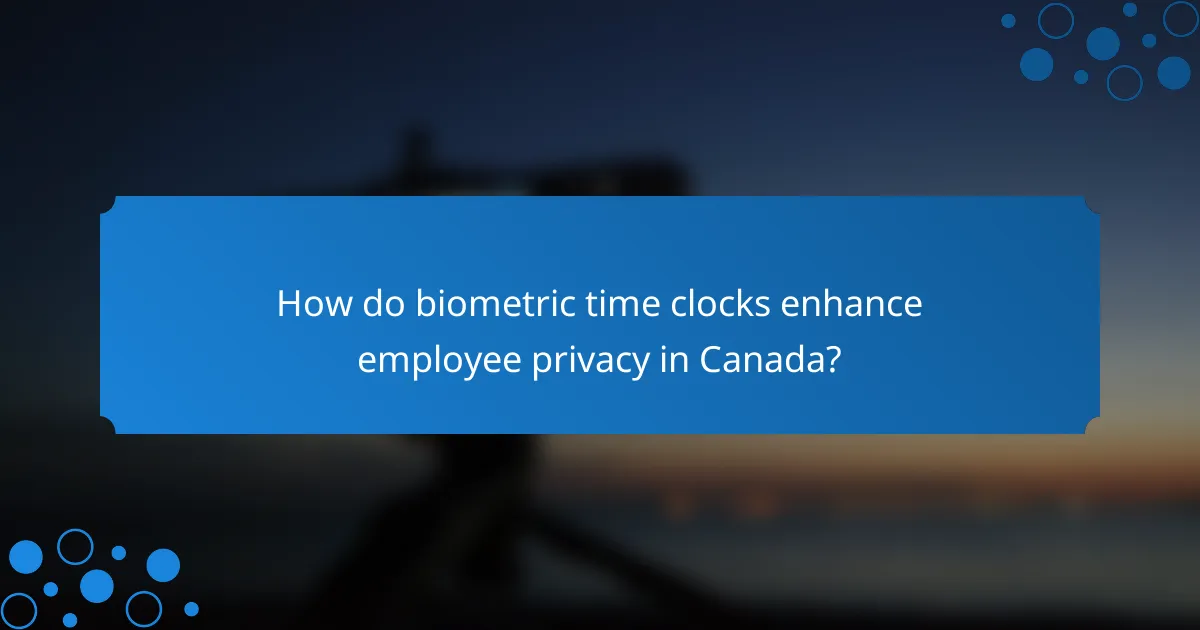
How do biometric time clocks enhance employee privacy in Canada?
Biometric time clocks enhance employee privacy in Canada by securely capturing and storing unique physical traits, such as fingerprints or facial recognition data, while minimizing the risk of unauthorized access. These systems prioritize data protection through advanced security measures and compliance with privacy laws.
Data encryption methods
Data encryption methods are crucial for protecting biometric information. Biometric time clocks often use strong encryption algorithms to secure data both in transit and at rest, ensuring that sensitive employee information is not easily intercepted or accessed by unauthorized parties.
Common encryption standards include AES (Advanced Encryption Standard), which is widely regarded for its robustness. By implementing these methods, companies can significantly reduce the risk of data breaches and enhance overall employee privacy.
Compliance with privacy regulations
Compliance with privacy regulations is essential for biometric time clocks to operate legally in Canada. Organizations must adhere to the Personal Information Protection and Electronic Documents Act (PIPEDA), which mandates that personal data, including biometric information, be collected, used, and disclosed responsibly.
Employers should conduct regular audits and assessments to ensure their biometric systems meet these legal requirements. Non-compliance can lead to significant penalties and damage to the company’s reputation.
Employee consent mechanisms
Employee consent mechanisms are vital for ensuring that workers are aware of and agree to the use of biometric time clocks. Organizations should implement clear policies that outline how biometric data will be collected, used, and stored, allowing employees to make informed decisions.
Providing options for employees to opt-in or opt-out, along with transparent communication about data handling practices, fosters trust and enhances privacy. Regular training sessions can also help employees understand their rights regarding biometric data.
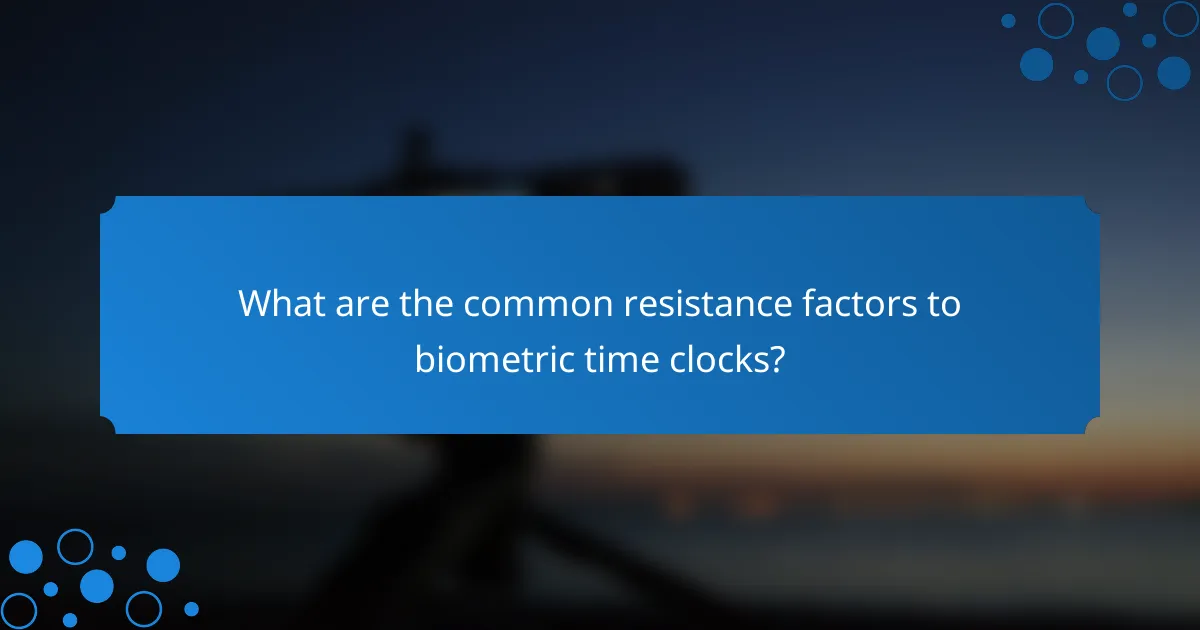
What are the common resistance factors to biometric time clocks?
Common resistance factors to biometric time clocks include employee concerns about surveillance, challenges in adapting to new technology, and cultural attitudes towards biometric systems. These factors can hinder the implementation and acceptance of biometric timekeeping solutions in the workplace.
Employee concerns about surveillance
Many employees worry that biometric time clocks infringe on their privacy by constantly monitoring their movements and behaviors. This concern can lead to feelings of distrust towards employers, as workers may perceive these systems as tools for excessive oversight rather than efficiency.
To address these concerns, employers should communicate transparently about how biometric data will be used, stored, and protected. Providing assurances that data will not be misused can help alleviate fears and foster a more trusting environment.
Technological adaptation challenges
Transitioning to biometric time clocks often requires employees to learn new systems and processes, which can be met with resistance. Some workers may feel uncomfortable with technology, particularly if they are accustomed to traditional methods like punch cards or manual time tracking.
Employers can ease this transition by offering comprehensive training sessions and ongoing support. Demonstrating the benefits of biometric systems, such as increased accuracy and reduced time theft, can also encourage acceptance among staff.
Cultural attitudes towards biometrics
Cultural perceptions of biometrics vary significantly across regions and industries. In some cultures, there is a strong acceptance of biometric technology, while in others, it may be viewed with skepticism or fear due to privacy concerns.
Understanding the cultural context of the workforce is crucial for successful implementation. Employers should consider conducting surveys or focus groups to gauge employee sentiment and tailor their approach accordingly, ensuring that the introduction of biometric time clocks aligns with the values and expectations of their staff.
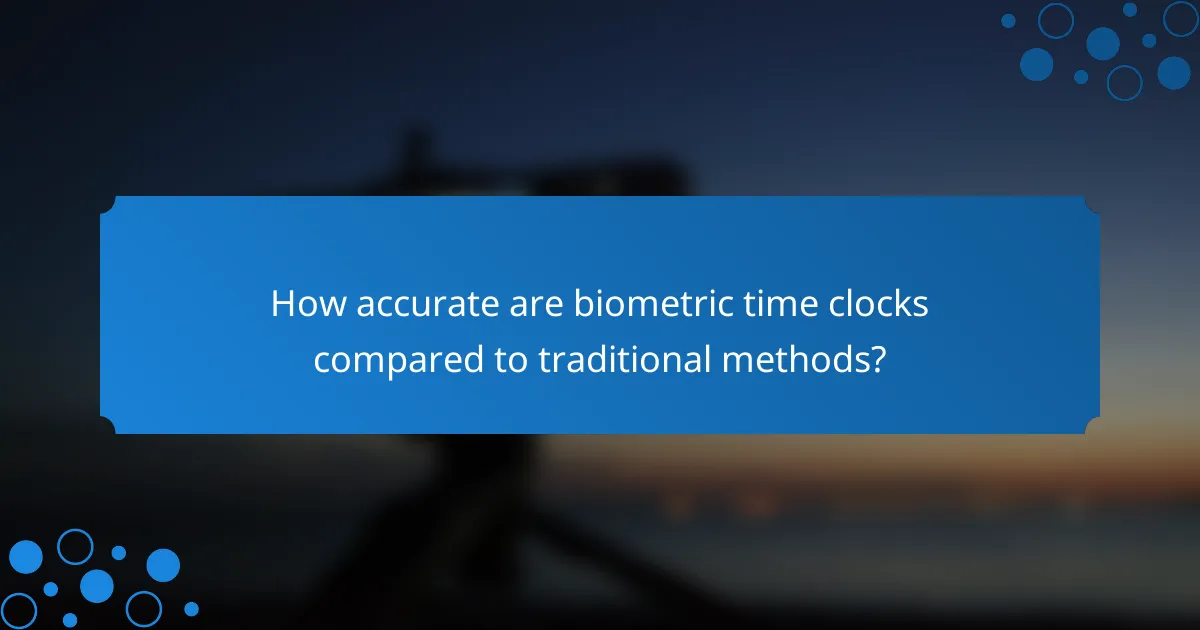
How accurate are biometric time clocks compared to traditional methods?
Biometric time clocks generally offer higher accuracy than traditional methods like punch cards or manual entry. They rely on unique physical traits, such as fingerprints or facial features, which significantly reduce the chances of time theft or buddy punching.
Accuracy rates of fingerprint scanners
Fingerprint scanners typically boast accuracy rates above 95%, making them reliable for employee time tracking. However, the effectiveness can vary based on the quality of the scanner and the condition of the user’s fingers, such as dryness or cuts.
To ensure optimal performance, regular maintenance and calibration of the fingerprint scanners are essential. Employers should also provide guidance on proper finger placement to minimize errors.
Facial recognition technology performance
Facial recognition technology has improved significantly, with accuracy rates often exceeding 90%. This technology analyzes facial features and can function well in various lighting conditions, although it may struggle with obstructions like masks or hats.
For best results, organizations should choose systems that can adapt to different environments and provide training for employees on how to position themselves correctly during scans.
Impact of environmental factors on accuracy
Environmental factors can greatly influence the accuracy of biometric time clocks. For instance, extreme temperatures, humidity, or poor lighting can affect both fingerprint and facial recognition systems.
To mitigate these issues, employers should install biometric devices in controlled environments, ensuring adequate lighting and temperature. Regularly assessing the performance of these systems can help identify and address any environmental impacts on accuracy.
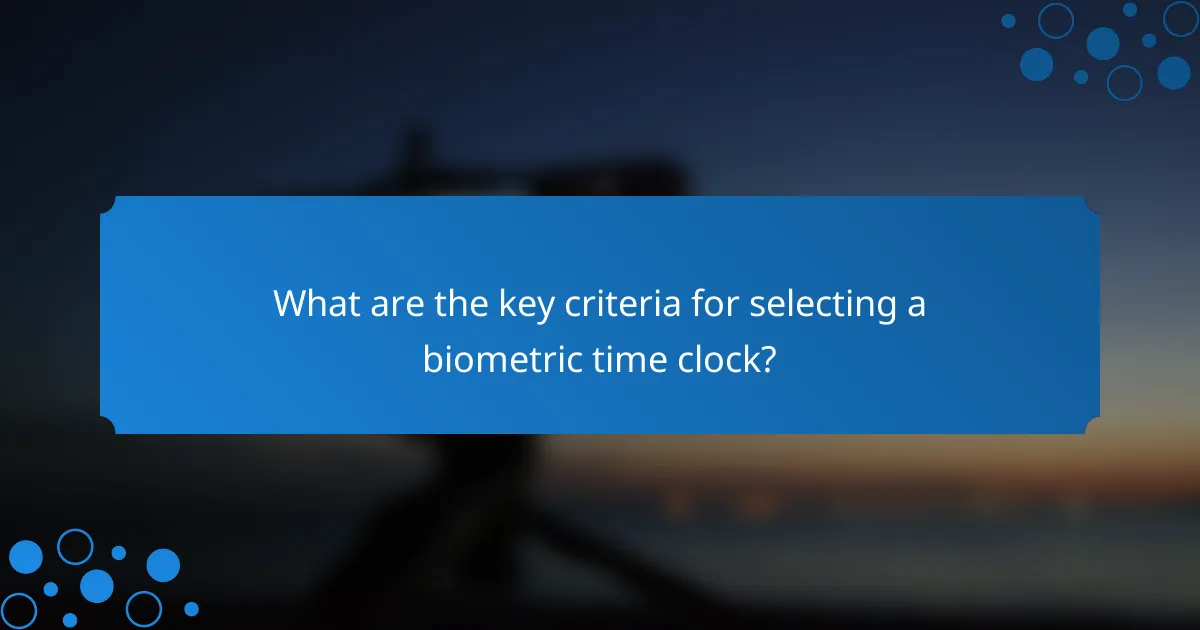
What are the key criteria for selecting a biometric time clock?
When selecting a biometric time clock, consider integration with existing HR systems, cost-effectiveness, and the potential return on investment (ROI). These criteria ensure that the chosen system meets organizational needs while enhancing efficiency and accuracy in time tracking.
Integration with existing HR systems
Choosing a biometric time clock that integrates seamlessly with your current HR systems is crucial. Look for systems that support popular HR software platforms to avoid data silos and streamline payroll processing. Compatibility can significantly reduce administrative workload and errors.
Evaluate the ease of integration by checking for available APIs or pre-built connectors. This can save time and resources during the implementation phase, allowing for a smoother transition to the new system.
Cost-effectiveness and ROI analysis
Assessing the cost-effectiveness of a biometric time clock involves analyzing both initial investment and ongoing operational costs. Consider factors such as hardware expenses, software licensing, and maintenance fees. A comprehensive ROI analysis should factor in potential savings from reduced time theft and improved payroll accuracy.
To gauge ROI, estimate the time saved in payroll processing and the reduction in errors. A well-chosen biometric system can yield returns in the range of 20-30% over its lifespan, depending on the size of your workforce and existing inefficiencies.

What are the emerging trends in biometric time clock technology?
Emerging trends in biometric time clock technology focus on enhancing accuracy, user experience, and compliance with privacy regulations. These advancements are reshaping how organizations track employee time and attendance, making systems more efficient and secure.
Advancements in AI and machine learning
AI and machine learning are significantly improving biometric time clock systems by enhancing their accuracy and speed. These technologies enable systems to learn from user behavior, reducing false positives and negatives in fingerprint or facial recognition. As a result, organizations can expect quicker clock-ins and clock-outs, often within low tens of milliseconds.
Additionally, AI can analyze patterns in attendance data, helping employers identify trends and make informed decisions regarding workforce management. This predictive capability can lead to better staffing and scheduling, ultimately improving productivity.
Increased focus on user experience
Modern biometric time clocks are increasingly designed with user experience in mind, making them more intuitive and accessible. Features such as touchless recognition and mobile integration allow employees to clock in and out seamlessly, reducing friction in the process. This focus on usability can lead to higher employee satisfaction and compliance with attendance policies.
Employers should consider providing training sessions or informational resources to help employees adapt to new systems. Clear communication about the benefits of biometric technology can ease resistance to change and foster a positive reception.
Future privacy regulations and compliance
As biometric data collection becomes more prevalent, future privacy regulations are likely to tighten, requiring organizations to ensure compliance. Companies must be prepared to navigate laws that govern the collection, storage, and use of biometric information, which may vary significantly by region. For instance, regulations in the EU under GDPR impose strict guidelines on personal data, including biometric data.
Organizations should implement robust data protection measures and maintain transparency with employees about how their biometric data is used. Regular audits and updates to privacy policies can help ensure compliance and build trust among the workforce.
